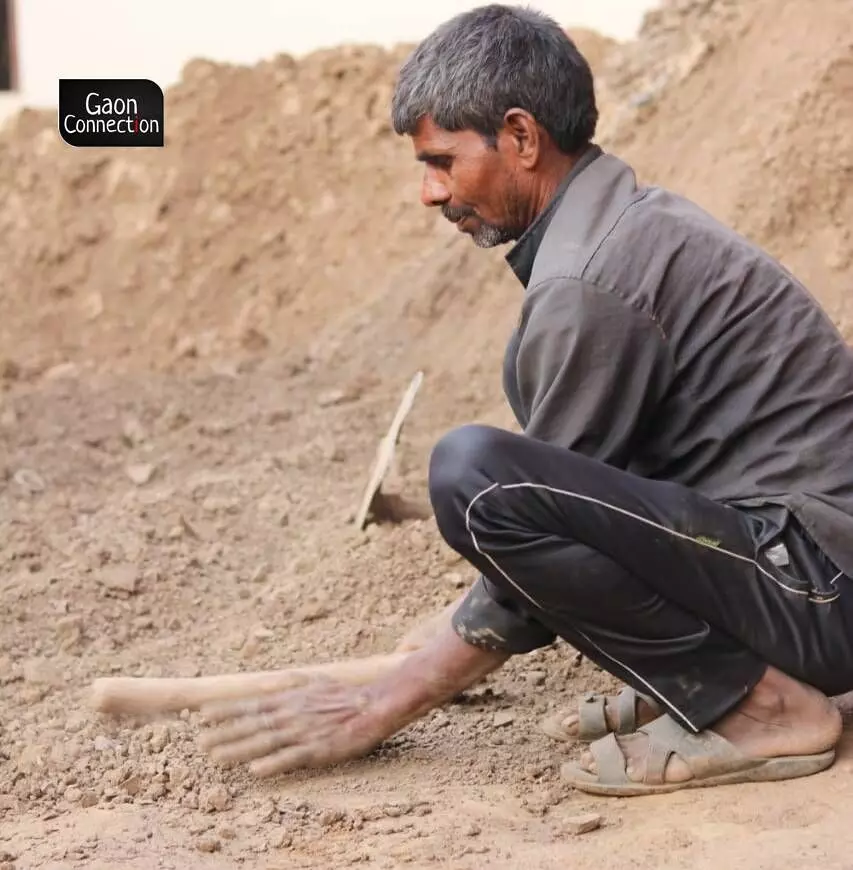Alwar, Rajasthan
In the 25 years that he has been a potter, Om Prakash Galav has not only made a name for himself, but has also taught his craft to five thousand other people across the country.
A resident of Ramgarh in Alwar district, Rajasthan, 40-year-old Om Prakash has given traditional pottery a makeover and has earned fame for his incredible skill of making them paper-thin. His craft has been lauded both nationally and internationally.
“This is an occupation that has come down to me from my ancestors. My great grandfather Pahalwan Lalluram, grandfather Sohanlal and father Fatehram, all worked with mud and were well known for it,” Om Prakash told Gaon Connection. His mother Heera Devi still helps him design his products. “She has won awards at the district level,” he added.
The process of making these wafer-thin pottery is long and challenging, said Om Prakash. “I mostly make artistic vessels, pots, lamps, idols, terracotta jewellery, and so on. I also make clay objects on demand. I add no chemicals to the clay I use to make these,” said the potter.
According to him, the pots and artefacts he makes use less volume of mud when compared to the regular pottery.

Also Read: She studied till class 9, but is now a businesswoman who supports 200 rural women
How to make wafer-thin pottery
Explaining the process of making paper-thin pottery, Om Prakash said: “The mud for my work comes from within a 50 kilometres radius. I get it in trolleys with one load costing me anything between Rs 3,000 and Rs 4,000. The first thing I do on getting the mud is to dry it thoroughly.”
The mud is then sieved and the fine soil is kept aside. The leftover mud is beaten further to make it finer and then poured into a haare, or a pit on the ground, and covered with water. It is once again sieved to remove any stones and other impurities. The mud is all kneaded together and kept covered in plastic for two days.
“We then take portions of the clay and shape them over the potter’s wheel. It is the dexterity of our fingers that create the magic and make such fine pottery,” smiled the potter.
Once the vessel is removed from the wheel, it undergoes a lot more processes. It is smoothened, maybe designs are etched on it and all the while it is made finer and finer. Finally the products are kept to dry in the shade for eight to ten days. Sometimes they are dipped in red mud to give them that reddish hue, explained Om Prakash. The last thing to be done is the vessels are polished with a thin, soft mulmul cloth that gives them an incredible shine, and baked in the oven.

“This is the reason the paper-think products I make cost so much more than the regular pottery, sometimes five to ten times more,” explained Om Prakash.
“Before I start the process, which is in itself very different from the steps followed in regular pottery making, I already have the image of the finished product in my mind and through the process, that remains there,” said the potter.
Also Read: The Galicha Makers of Dholpur
Accolades and awards
Om Prakash, who once sold his products out of his home, now has a website. He is listed on Amazon as Ramgarh Clay Pottery and only earlier this year he started a website by the same name.
Om Prakash has won awards at the district, state and national levels. He has won four international awards too. He also finds mention in the Unique World Records book, in 2012. The potter has participated in exhibitions in the Netherlands, England, Sweden, Nepal and France.
In 2003, Om Prakash won a district award, in 2006 and 2008 he won the state award and in 2010, he won a national award. In 2012, the World Arts Council presented him the UNESCO Award of Excellence for Handicrafts. He was once again awarded the same award in 2014 for his filigree vessel and a miniature hukka, and so on. In 2017, Crafts Village India gave him the International Craft Award.
Inspiration to other potters
The art and craft of Om Prakash is well appreciated amongst his peers some of whom have even learnt from him. He has spared no effort to share his skills and many are benefitting from that.
“I usually made the usual pots and pans, but once I learnt the finer aspects of Om Prakash’s techniques, I now make more aesthetic products and have also begun travelling to exhibitions elsewhere,” Ram Prasad, a potter from Andhwari village in Alwar, told Gaon Connection.
Similarly, Rajesh Prajapat from Hakar Ji Sagwara village in Alwar also trained under Om Prakash. “He taught me the finer points of the techniques he himself uses. Today my business is doing well thanks to that training he gave. I have people coming from far and near to buy clay pottery from me,” Prajapat told Gaon Connection.
The paper-pottery potter also provides employment to seven or eight people in his workshop and provides them with a comfortable livelihood.
Promoting craftspeople
“In order to encourage craftspeople, the Industries Department under the Chief Minister Small Industries Promotion Scheme, has set aside three lakh rupees that is given to them as loan, the interest for which is given as subsidy by the government,” MR Meena, General Manager of the Industries department, told Gaon Connection.
Craftspeople are also given support by the government that pays for 50 per cent of the stall rents they may have to pay as well as takes care of their travel and stay in the places the exhibitions are held, he said.
However, Om Prakash said he has not availed of any of these benefits.




















